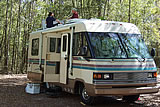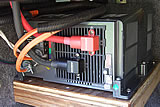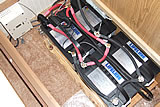“I went to the woods because I wished to live deliberately.”
— Henry David Thoreau, 1854
Living Deliberately
RV Electric and Solar
- Two 75-watt Siemens Pro 4-JF Solar Panels
- BZ Products MPPT 500 Power Point Solar Charge Booster
- Magnum ME 2012 Inverter Charger
- Magnum ME-RC Remote Control Panel
- Four Concord Lifeline AGM 100-amp/hour deep cycle batteries
- 2/0 Flex-A-Prene heavy-duty welding cables 600V
- Brass battery terminals and connectors
- Actual heat-shrink, not taped
Palmer Energy Systems Lake City, Florida
We would not be able to do what we are doing, or go  where we are going,
without a reliable electrical system for our
where we are going,
without a reliable electrical system for our  rig.
John Palmer at Palmer Energy Systems has one of the
highest reputations in the RV industry. He helped us
create a custom electrical system made for our off-the-grid
living, using top-of-the-line equipment that is manufactured
domestically. His craftsmanship and attention to detail are
impressive, and he encouraged us to participate in the installation
process so we could learn all about the components — which is important
when you may have to do your own repairs on the road. At his invitation,
we spent several days at his
rig.
John Palmer at Palmer Energy Systems has one of the
highest reputations in the RV industry. He helped us
create a custom electrical system made for our off-the-grid
living, using top-of-the-line equipment that is manufactured
domestically. His craftsmanship and attention to detail are
impressive, and he encouraged us to participate in the installation
process so we could learn all about the components — which is important
when you may have to do your own repairs on the road. At his invitation,
we spent several days at his  forested facility
to test our new system
and make sure it worked for our needs. When we realized we would rather
have the
forested facility
to test our new system
and make sure it worked for our needs. When we realized we would rather
have the  inverter in our storage compartment instead of the living
cabin as originally installed, he switched it out the next morning without
question. We would strongly recommend John Palmer at Palmer Energy Systems
to any RVer or boondocking aspirant.
inverter in our storage compartment instead of the living
cabin as originally installed, he switched it out the next morning without
question. We would strongly recommend John Palmer at Palmer Energy Systems
to any RVer or boondocking aspirant.
http://www.palmerenergysystems.com
External Power Plant — Gasoline Generator
- Robin-Subaru R1100 Generator
- Rated 7.5 amps AC
Hildebrande Engines Largo, Florida
Solar power is fantastic, but overcast days come now and then.
And sometimes it’s just nice to park in the shade.
Plus, in the real world, solar alone can never quite “top off” the batteries to a full charge.
For these reasons and more, we really loved our on board Onan 2.8 Microlite Generator.
But this old generator — part of the RV’s original equipment — was also the least
reliable component of our system. Noisy and gas-thirsty, it had a penchant to pollute.
So we took it to Mike and Charles Hildebrand at Hildebrand’s Engines to bump it up to
21st century standards. Alas, the old generator was too far gone to repair.
So we bought a brand new external  generator instead —
one that uses
little gas and is very quiet. We can now pull into any boondocking campsite or wilderness
area and top off our
generator instead —
one that uses
little gas and is very quiet. We can now pull into any boondocking campsite or wilderness
area and top off our  batteries without disturbing the peace.
Best of all,
thanks to our
batteries without disturbing the peace.
Best of all,
thanks to our  solar panels, we use less than
¼ gallon of gas for a complete
bulk charge. We recommend Hildebrand’s Engines if you want to buy your own
Robin-Subaru generator.
solar panels, we use less than
¼ gallon of gas for a complete
bulk charge. We recommend Hildebrand’s Engines if you want to buy your own
Robin-Subaru generator.
http://hildebrandsengines.bravehost.com/
Internet and Communications
- Datastorm F1 Tri-A 1-watt satellite transmitter
- MotoSat D3 positioner/controller
- Hughes 7000S modem
- Linksys WRT 54G wireless router
Datastorm of Florida Pembroke Pines, Florida
Since we planned to take our home to very remote places, we could not count on cell phone towers to connect with the outside world.
We needed a communications system that we could use anywhere. Our solution: satellite internet.
But it turned out that mobile satellite internet equipment was more complex and required more precision
than the typical satellite television reception that most RVers use. Fortunately, we had the help of one of the best satellite
internet installers in the country. Tony and Paul Arcuri of Datastorm of Florida facilitated our research process,
and were always available by phone or email whenever we had any questions. As seasonal full-timers themselves,
they knew exactly what we were looking for as boondockers. They set us up with top-of-line equipment, professionally installed,
in less than three hours. We were provided with a generous warranty package, and Tony and Paul continue to be
available to us after the sale at any time. We strongly recommend Datastorm of Florida to any serious full-timer.
http://www.datastormflorida.com
Laptop Computers
- Dell Inspiron 1525 — modified!
- Intel Core 2 Duo T6400 (2.0GHz/800Mhz FSB/2MB cache)
- 3GB Shared Dual Channel DDR2 (2 Dimms)
- 250GB SATA Hard Drive (5400RPM)
Dell Computer
A computer that supports off-the-grid living will present some give-and-take challenges. You need the processor and system powerful enough
to interface with both web and desktop applications, but at the same time the processor must use the least amount of electricity as possible.
When we were searching for computers, the EPA had not yet finalized their
Energy Star specifications, so lots of independent
research went
into finding the right processor that represented the best cost/benefit ratio. (A $3000 computer sorta defeats the point, right?) With our
Good Sam Club membership discount, we found what we needed in a relatively inexpensive Dell laptop. The Intel Core 2 Duo T6400 processor with
the Penryn architecture, at the time of our purchase, was the best chip for our buck, with a processor nanometer of only 45 AC watts.
In actual use, we have found this to be a very buffered ceiling, as each of our Dell laptops uses at most only 18 AC watts (or 0.15 AC amps)
each, which translates to only 1.5 DC amps(!) — as such, we can operate two laptops and the internet modem all plugged in and charging the
 batteries off just two
batteries off just two  solar panels.
solar panels.
http://www.dell.com
RV Insurance
GEICO
We have been happy with GEICO’s service for over a decade. So when we found out they had RV insurance specifically for full-timers, it was a no-brainer.
http://www.geico.com
Our Toad
- Xtreme Expresso 50 QT-2 49cc Scooter
Axis Powersports
Inverness, Florida
Once we get to where we’re going and hunker down (not a simple process!) there’s no sense in moving our whole house to run to the store,
or explore the town, or get us to the next trailhead. That’s what we have our scooter for. In RV-speak, the vehicle you tow behind your rig is your
“toad”. Our toad weighs only 170 pounds, travels by rack on the trailer hitch, and gets 100 miles per gallon. It’s perfect for the two of us and a lot of fun.
Derick and Angela David at Axis Powersports were very patient with us. We asked a lot of questions about small engines, scooter laws and scooter maintenance.
They made the purchase easy and fun. Most importantly, they have always been available to us after the sale as our questions arise, even though we are “out-of-town”.
We highly recommend Axis Powersports to anybody in the market for a scooter, ATV or dirt bike.
http://www.axis-powersports.com












